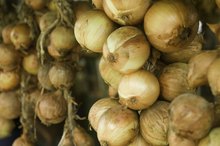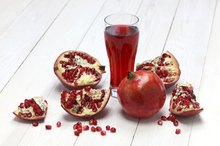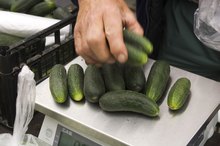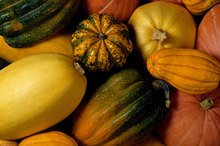What does fact checked mean?
At Healthfully, we strive to deliver objective content that is accurate and up-to-date. Our team periodically reviews articles in order to ensure content quality. The sources cited below consist of evidence from peer-reviewed journals, prominent medical organizations, academic associations, and government data.
- National Institutes of Health: Vitamin K
- National Institutes of Health: Vitamin A
- Harvard School of Public Health: The Nutrition Source Three of the B Vitamins: Folate, Vitamin B6, and Vitamin B12
The information contained on this site is for informational purposes only, and should not be used as a substitute for the advice of a professional health care provider. Please check with the appropriate physician regarding health questions and concerns. Although we strive to deliver accurate and up-to-date information, no guarantee to that effect is made.
Peeled Cucumbers & Vitamin K
Cucumbers are a cool, refreshing summer treat when sliced and put in salads, marinated in vinegar, or eaten raw. Low in calories and high in fiber and minerals, cucumbers are a safe addition to any diet. When it comes to vitamins, the most abundant one in cucumbers is vitamin K. Since vitamin K's primary role is to clot the blood, you should speak to your doctor before eating foods that contain vitamin K if you are on blood thinners.
Vitamin K
Peeling your cucumber will reduce its vitamin K content and eliminate any pesticides that may be on the skin. The vitamin K in cucumber is found primarily near the peel, so peeling your cucumber significantly reduces the amount you will consume. For example, a one cup serving of cucumber with the peel contains 17 micrograms of vitamin K, while a one cup serving without the peel contains 8.6 micrograms, according to the USDA National Nutrient Database 123. The 17 micrograms is 11 percent of the recommended daily value, so eating a cup of sliced, peeled cucumbers on a salad or as a side dish significantly contributes to your daily intake. Vitamin K's primary role is in the proper clotting of blood, and without it, a simple cut may cause you to bleed to death. The National Institutes of Health reports that it also plays a role in maintaining bone health 23.
Vitamin C
Do Onions Have Vitamin K?
Learn More
Peeled cucumbers also contain a fair amount of vitamin C, with a one cup serving containing 3.8 mg, which is 6 percent of the recommended daily intake. Vitamin C is not stored in the body, which means you need to replace your vitamin C levels daily to partake of its health benefits, which are many 23. Vitamin C is necessary for the production of collagen, which is the building material for healthy skin as well membranes that line your blood vessels and the inside of your body. As an antioxidant, vitamin C also protects the cells in your body from free radical damage, which can lead to chronic disease. The best known role of vitamin C may be its immune system support, which helps you fight colds and the flu.
- Peeled cucumbers also contain a fair amount of vitamin C, with a one cup serving containing 3.8 mg, which is 6 percent of the recommended daily intake.
- Vitamin C is not stored in the body, which means you need to replace your vitamin C levels daily to partake of its health benefits, which are many 2.
Vitamin A
Peeled cucumbers contain 85.7 IU of vitamin A in a one cup serving, which is 2 percent of the RDI. Vitamin A works with vitamin C as an antioxidant, and it also works to maintain eyesight and eye health. Other vegetables high in vitamin A are carrots, spinach, sweet potatoes and kale.
- Peeled cucumbers contain 85.7 IU of vitamin A in a one cup serving, which is 2 percent of the RDI.
- Other vegetables high in vitamin A are carrots, spinach, sweet potatoes and kale.
B Vitamins
What Vitamins Do Mangoes Have?
Learn More
Peeled cucumbers also contain trace amounts of the B vitamins, with folate or B9 being the highest at approximately 16.7 micrograms in a one cup serving, or 4 percent of the RDI. Other B vitamins include B6, pantothenic acid, riboflavin and thiamin. The Harvard School of Public Health reports that folate and B6 play a role in protecting you from heart disease and some cancers. All B vitamins are necessary for the production of red blood cells and energy metabolism.
- Peeled cucumbers also contain trace amounts of the B vitamins, with folate or B9 being the highest at approximately 16.7 micrograms in a one cup serving, or 4 percent of the RDI.
- All B vitamins are necessary for the production of red blood cells and energy metabolism.
Related Articles
References
- USDA National Nutrient Database: Keyword--Cucumber; Peeled
- National Institutes of Health: Vitamin K
- National Institutes of Health: Vitamin A
- Davey, M. W., Montagu, M. V., Inzé, D., Sanmartin, M., Kanellis, A., Smirnoff, N., ... & Fletcher, J. (2000). Plant Lâascorbic acid: chemistry, function, metabolism, bioavailability and effects of processing. Journal of the Science of Food and Agriculture, 80(7), 825-860.
- Alessio, H. M., Hagerman, A. E., Fulkerson, B. K., Ambrose, J. E. S. S. I. C. A., Rice, R. E., & Wiley, R. L. (2000). Generation of reactive oxygen species after exhaustive aerobic and isometric exercise. Medicine and Science in Sports and Exercise, 32(9), 1576-1581.
- Padayatty, S. J., Katz, A., Wang, Y., Eck, P., Kwon, O., Lee, J. H., ... & Levine, M. (2003). Vitamin C as an antioxidant: evaluation of its role in disease prevention. Journal of the American College of Nutrition, 22(1), 18-35.
- Bendich, A., & Langseth, L. (1995). The health effects of vitamin C supplementation: a review. Journal of the American College of Nutrition, 14(2), 124-136.
- Douglas, R. M., & Hemilä, H. (2005). Vitamin C for preventing and treating the common cold. PLoS Medicine, 2(6), e168.
- Bryer, S. C., & Goldfarb, A. H. (2006). Effect of high dose vitamin C supplementation on muscle soreness, damage, function, and oxidative stress to eccentric exercise. International Journal of Sport Nutrition and Exercise Metabolism, 16(3), 270-280.
- Nakhostin-Roohi, B., Babaei, P., Rahmani-Nia, F., & Bohlooli, S. (2008). Effect of vitamin C supplementation on lipid peroxidation, muscle damage and inflammation after 30-min exercise at 75% VO^ sub 2max^. Journal of Sports Medicine and Physical Fitness, 48(2), 217.
- Li, H., Zou, Y., & Ding, G. (2012). Dietary factors associated with dental erosion: a meta-analysis. PloS One, 7(8), e42626.
- Moertel, C. G., Fleming, T. R., Creagan, E. T., Rubin, J., O'Connell, M. J., & Ames, M. M. (1985). High-dose vitamin C versus placebo in the treatment of patients with advanced cancer who have had no prior chemotherapy: a randomized double-blind comparison. New England Journal of Medicine, 312(3), 137-141.
- Bruno, R. S., Leonard, S. W., Atkinson, J., Montine, T. J., Ramakrishnan, R., Bray, T. M., & Traber, M. G. (2006). Faster plasma vitamin E disappearance in smokers is normalized by vitamin C supplementation. Free Radical Biology and Medicine, 40(4), 689-697. .
- Huang, J., & May, J. M. (2003). Ascorbic acid spares α-tocopherol and prevents lipid peroxidation in cultured H4IIE liver cells. Molecular and Cellular Biochemistry, 247(1), 171-176.
- Kalgaonkar, S., & Lönnerdal, B. (2008). Effects of dietary factors on iron uptake from ferritin by Caco-2 cells. The Journal of Nutritional Biochemistry, 19(1), 33-39.
- Monsen, E. R. (2000). Dietary reference intakes for the antioxidant nutrients: vitamin C, vitamin E, selenium, and carotenoids. Journal of the American Dietetic Association, 100(6), 637-640.
Writer Bio
A certified nutritionist who majored in health, fitness and nutrition, Traci Vandermark has been writing articles in her specialty fields since 1998. Her articles have appeared both online and in print for publications such as Simple Abundance, "Catskill Country Magazine," "Birds and Blooms," "Cappers" and "Country Discoveries."









